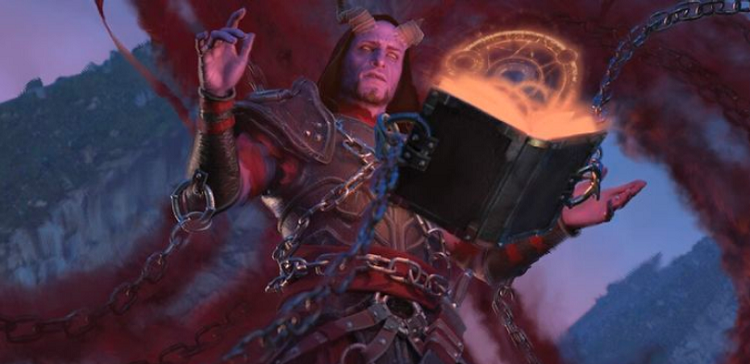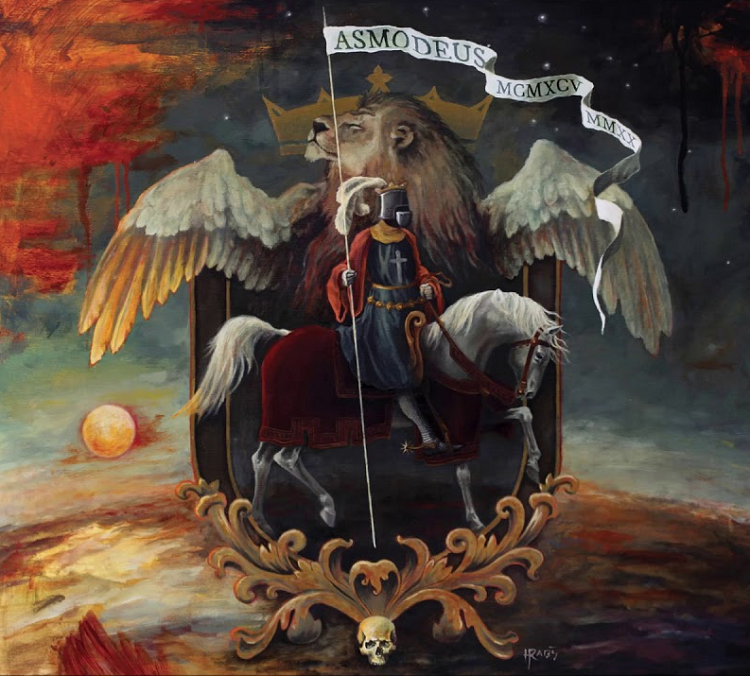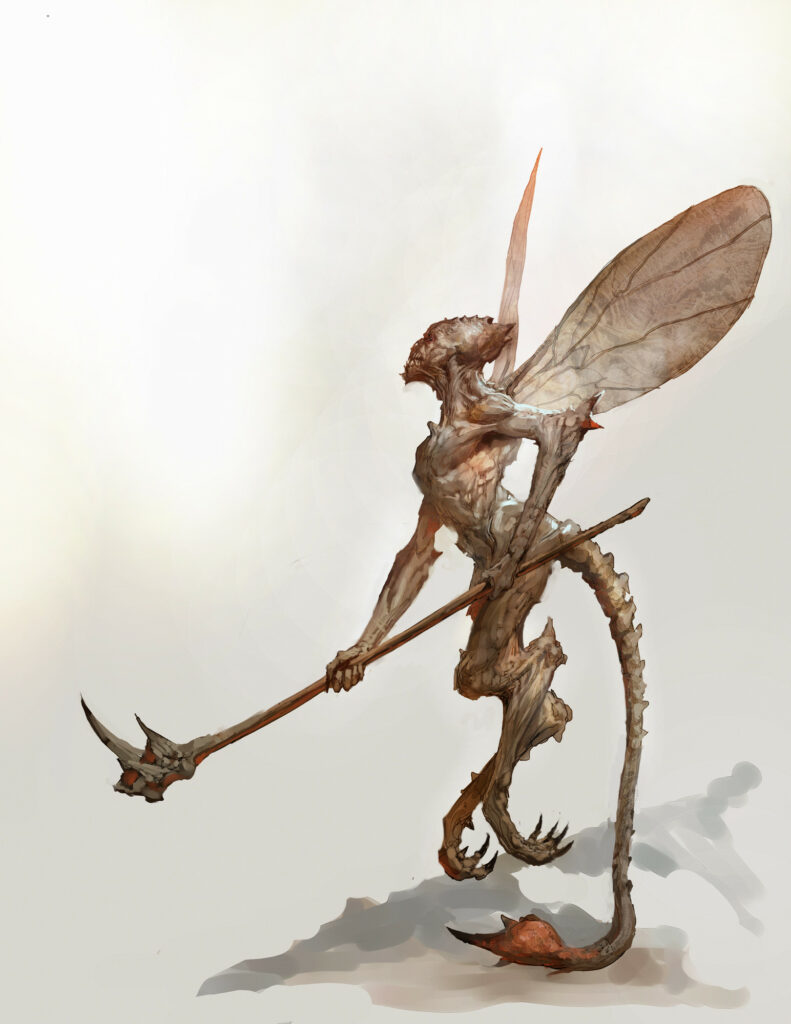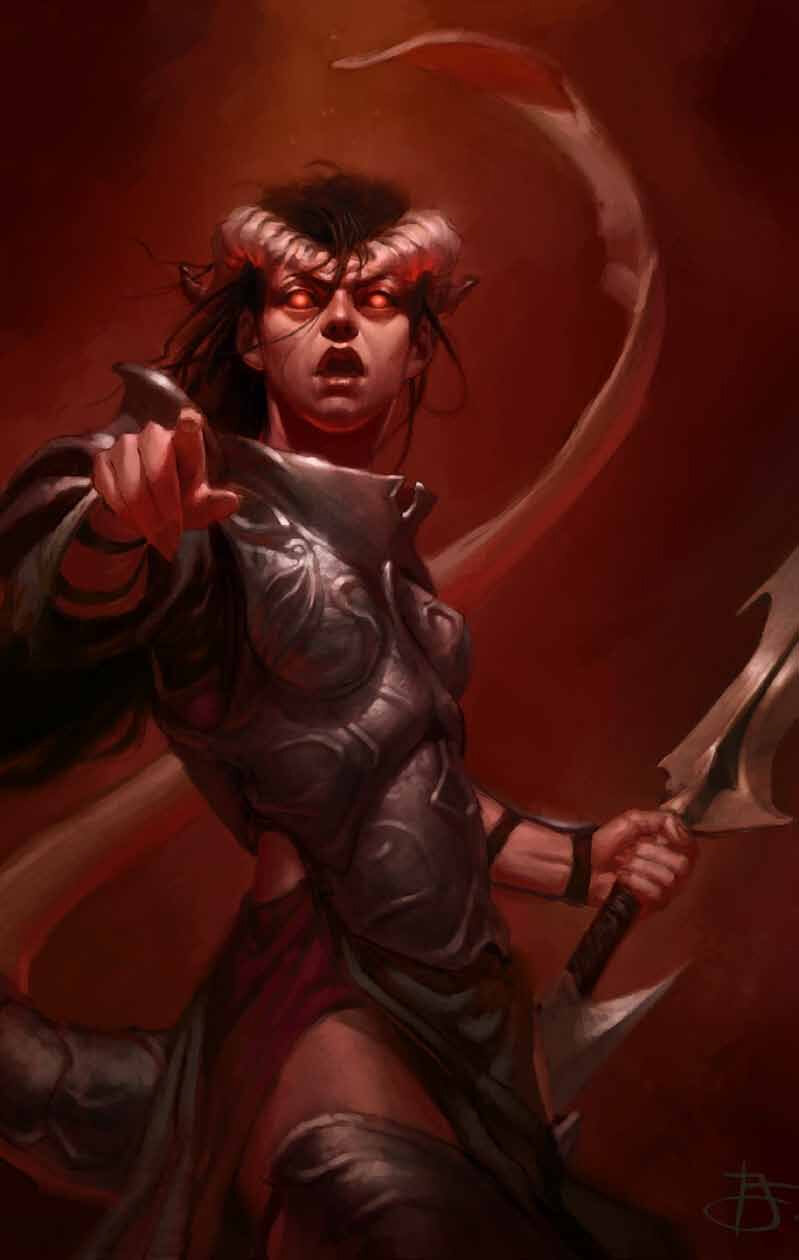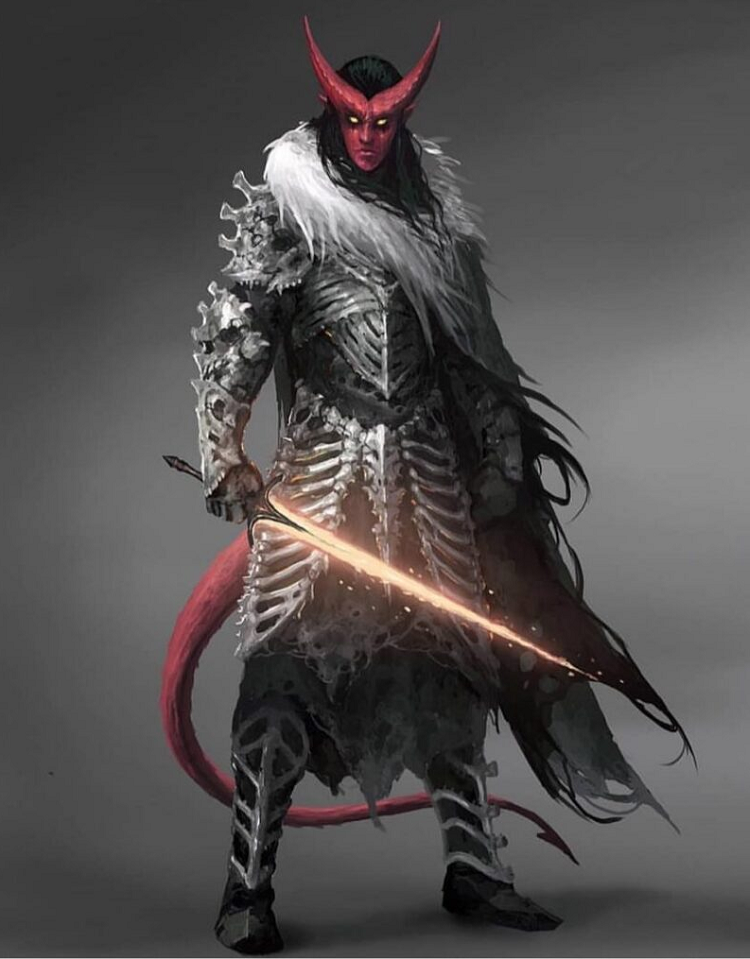The two most important decisions you can make as a D&D player are your character’s class and race. There are many races to choose from in the D&D universe, even if you only want to limit yourself to the 5e Player’s Handbook (PHB). While not part of the earlier editions of PHB, few races have attracted more interest among players. Let’s begin our Tiefling 5e Guide by looking at what Tieflings actually are.
What are Tieflings?
As per 5th Edition PHB, Tieflings are beings that have a mix of human and devil bloodlines, specifically Asmodeus, Overlord of the Nine Hells. (PHB, p. 42) This breeding was the result of a pact made ages ago, as part of some diabolical, long-term plan that may take several ages to come to fruition.
They have horns of varying sizes and shapes: ram horns, bull horns, etc. They have thick, prehensile tails that are almost as long as their bodies are tall.
The color of their skin varies, from that which is found in humans to different hues of red or pink. Their teeth are sharp.
Their eyes have no visible sclera or pupil Eye colors include:
- Black
- Red
- White
- Silver
- Gold
Hair colors include:
- Black
- Brown
- Dark red
- Dark blue
- Dark purple
While their heritage is evil, they do not have to choose to be evil. Regardless, society is understandably prejudiced against them, and many choose evil as a rebellion against an unjust society.
Who is Asmodeus?
Asmodeus is the Archfiend Overlord of the Nine Hells. In the D&D universe, the Nine Hells are on a different plane of existence than our world.
The Nine Hells are controlled by 8 archdukes and Asmodeus, their overlord. Each hell is ruled by a different archduke and each archduke is actually an archfiend. Fiend is a general term for a devil or demons.
Archfiend is a term for any devil or demon nobility: duke, prince, lord, etc. The hierarchy of the Nine Hells, and most of its population, consists of devils, not demons. Demons have their own plane, the 666 Layers of the Abyss.
Nessus, the Ninth Hell, is ruled by Asmodeus and its capital is Malsheem. Asmodeus is handsome with a well-groomed mustache and pointy beard and in many ways resembles the classic image of the Devil we have in Christianity. He carries a ruby rod, an artifact that has tremendous power.
Asmodeus, as the player character’s distant ancestor, may or may not play a role in the campaign, directly or indirectly through fiendish intermediaries. The thing to understand when dealing with Asmodeus is that he and his world are lawful evil, not pure evil. Asmodeus is not a cartoon villain that simply lusts for power.
His motivations are deeper. Feeling threatened by chaos, he wants to bring order to the cosmos at all costs, including the cost of the good.
Players who wish to experience being an evil character can agree with Asmodeus and use their family connections to become his prized servants. Such a choice has a price.
They could, however, make a different choice and rebel against Asmodeus. Such a choice also has a price.
This is what it means to be a tiefling. You can either make a deal with the Devil and give him your soul as payment, or you can break a deal with the Devil that you didn’t even make, and incur his wrath. Tieflings are literally damned if they do and damned if they don’t.
Worse. Nobody cares. Good people don’t care about tiefling-problems because they think tieflings are evil. Evil people don’t care about tieflings because they care about nobody but themselves.
What are the Advantages of Being a Tiefling?
Tieflings have Darkvision, innate magic, and innate resistance. They also gain bonuses on their ability scores.
Ability Scores: +2 Charisma, +1 Intelligence
Their innate magic is referred to as Infernal Legacy. Charisma is the modifier for these spells which can be replenished after a long rest. Thaumaturgy is not a spell, but a cantrip, so it can be cast at will and does not need to be replenished with a long rest or any rest:
- Thaumaturgy as a cantrip
- Hellish Rebuke Spell as 2nd level spell, but only when the character reaches 3rd level or higher
- Darkness Spell, but only when the character reaches 3rd level or higher
Their innate resistance, Hellish Resistance, gives them resistance to fire damage.
- Darkvision: 60 feet
- Languages: Common and Infernal
Tiefling Character Build: The Bard
One of the main reasons players choose to pick a character of a different race is the character build aspect.
This is very specific character building because humans have a higher total of ability score increases (ASIs), +6 total, than any of the other races. Tieflings, for example, have a total of an ASI of +3, +2 Charisma and +1 Intelligence.
Of course, humans can only add 1 point to each ability. Most other races, however, can add 2 points to at least 1 ability.
Since Charisma is a tiefling’s +2, four classes are quite obvious:
- Bard
- Sorcerer
- Warlock
- Paladin
For my sample tiefling character build, I’m going to pick bard.
Tiefling Bard: Ability Scores
Of course, if you’re good with dice and you think you can roll an 18 or two, that’s what you should do. Then you can add your +2 for a 20 Charisma and start wreaking havoc.
For the benefit of readers who are not natural dice-throwers, I’m basing character build decisions on the standard set of scores model PHB, p 13. The standard scores can be moved around into any sequence. Here is the standard sequence in descending order: 15, 14, 13, 12, 10, 8.
Because their needs are similar, the way I’ve allocated the scores for my tiefling bard is the same way I would also allocate for tiefling wizards, warlocks and sorcerers.
Paladin for Your Tiefling Character Build
I based this character build and most of this article on the Player’s Handbook because that is the core of the game. Also, not all DM’s want to use accessories like D&D Mordenkainen’s Tome of Foes and not all players want to have empty their wallets for additional books.
Obviously, those who want a tiefling paladin, choose a Charisma/Strength ASI like that of a Zariel bloodline tiefling.
For those who can’t/don’t want to go outside PHB, here is the ASI allocation I would suggest for paladins from the ASI tiefling bloodline based on the standard set of scores model:
Paladin Tiefling:
| Ability | Strength | Intelligence | Wisdom | Dexterity | Constitution | Charisma |
| Standard Scores | 15 | 14 | 13 | 12 | 10 | 8 |
| Customized Sequence | 15 | 14 | 8 | 10 | 13 | 14 |
| Racial Bonus | +1 | +2 | ||||
| Ability Scores Total | 15 | 15 | 8 | 10 | 13 | 16 |
| Ability Modifiers | +2 | +2 | -1 | +1 | +3 |
Paladins are expected to be tanks and the paladin above has lower Strength and Constitution scores than characters like Bruenor from the character build on PHB p. 13.
The saving grace for this Asmodeus paladin is that when 1st level paladins don’t get spells, this one at least has the Thaumaturgy cantrip. Also, if I had to navigate the lowest of the Nine Hells, Nessus, what better guide than a paladin of the Asmodeus tiefling bloodline?
Bards, Sorcerers, Warlocks, Wizards
| Ability | Strength | Intelligence | Wisdom | Dexterity | Constitution | Charisma |
| Standard Sequence | 15 | 14 | 13 | 12 | 10 | 8 |
| Customized Sequence | 8 | 15 | 10 | 14 | 13 | 14 |
| Racial Bonus | +1 | +2 | ||||
| Ability Scores Total | 8 | 16 | 10 | 14 | 13 | 16 |
| Ability Modifiers | -1 | +3 | +2 | +1 | +3 |
Notice that I didn’t add my +2 and my +1 to my 15 and 14, to get a 17 and a 15. The modifier for 16 is the same as 17, so two 16s are better than one 17. Therefore, I don’t add my +2 to my 15. This way, my two most important racial traits are at 16 with +3 modifiers.
Even though Charisma is a bard’s most important trait, for survivability, Dexterity and Constitution are important for most classes, including all of the classes represented in this particular table. For said classes, the best dump stats are Strength and Wisdom.
Tiefling Bard: Hit Points, Armor Class, Weapons
- HP 9, AC 14, Rapier +4/+2, Shortsword +4/+2, Hand Crossbow +4/+2, 2 Daggers +4/+2
- HP (Hit Points): 8 HP +1 (CON +1) = 9 HP
- As a bard, this tiefling starts with 8 hit points +1 for the Constitution modifier.
- AC (Armor Class): AC 12 (studded leather) +2 (DEX +2) = AC 14
As a bard, this tiefling has access to all light armor. Studded leather armor is the best non-magical light armor in the D&D world. There is no penalty for Stealth.
Normally, studded leather would provide an AC of 12, but this tiefling’s Dexterity modifier increases the AC to 14.
Studded leather isn’t cheap and a strict DM might not allow a 1st level bard to start out with studded leather, instead of just plain leather armor. This DM, however, would allow it because bards tend to be good at acquiring things and 45 gold pieces is not such a large sum compared to a full suite of plate.
Weapons: Rapier +4/+2, Shortsword +4/+2, Hand Crossbow +4/+2, 2 Daggers +4/+2
As a bard, this character has access to the following weapons:
- Simple weapons
- Hand crossbows
- Longswords
- Rapiers
- Shortswords
Unlike dwarves and elves, tieflings do not have added weapon proficiencies due to their race.
Because this tiefling has Strength 8 and Dexterity 14, any melee weapon that is not a finesse weapon is getting dumped. This eliminates longwords and most simple weapons.
My choice to carry a rapier, a finesse weapon that is not light, depends on the DM. Rapiers are finesse weapons that are not light. Rules as written (RAW), characters cannot do Two-Weapon Fighting with a rapier in one or both hands unless they have the Dual Wield feat.
As a DM, I would make an exception to this rule. Fighting with a rapier in both hands would require Dual Wield, but fighting with a rapier in one hand and a light weapon in the other should be considered Two-Weapon Fighting IMHO.
If the DM allows, my choice for melee combat would be Two-Weapon Fighting rapier and shortsword:
- Damage Rapier 1d8/1-8 +2. Shortsword 1-6 +0
- Total Damage 4-16/turn if both weapons hit
- If the DM doesn’t allow it, my choice for melee would be Two-Weapon Fighting double shortswords:
- Damage Rapier 1d6/1-6 +2. Shortsword 1-6 +0
- Total Damage 4-14/turn if both weapons hit
My hand crossbow would be a ranged weapon and my two daggers would serve as backups, for both melee and ranged weapons.
Tiefling Bard: Skill Proficiencies and Tool Proficiencies
As a tielfing, I don’t get additional skill and tool proficiencies because of my race, but I will acquire these things because of my class and background.
I know that the stereotype for bards is to pick the entertainer background, but in game terms, that is not going to be very useful, especially when exploring dungeons.
The urchin background, however, gives me Sleight of Hand and Stealth, both Dexterity skills. I also get Tool Proficiencies Thieves Tools and Disguise Kit, Dexterity and Intelligence proficiencies respectively.
These urchin proficiencies effectively turn my bard into a rogue that casts spells.
Urchin Background Proficiencies (Skill and Tool)
- Urchin Proficiencies: Sleight of Hand +2, Stealth +2
- Tool Proficiencies: Thieves’ Tools +2, Disguise Kit +3 (INT, PHB p. 178)
RAW, there is nothing that says a bard, or even a warlock, sorcerer, wizard, paladin, etc., can’t have an urchin background. If the DM doesn’t like it, tell him or her to start homebrewing the backgrounds so that the proficiency distribution is more equitable and practical!
Bard Class Skill Proficiencies
- Skill Proficiencies: Persuasion +3, Arcana +3, Investigation +3
One of the attractive features of the bard class is its skill proficiencies. Most classes, with the exception of rogues, only get to choose two skills proficiencies and they have to do it from a limited list. Bards get to choose 3 skills proficiencies from anything that exists in the game.
This gives me options that a 1st level rogue doesn’t have, like Arcana. Once the Jack of All Trades feature kicks in at 2nd level, my Skills Proficiencies will far outstrip those of my rogue counterparts.
Tiefling Bard: Spells
- Cantrips (3): Mage Hand, Vicious Mockery, (+Thaumaturgy for being tiefling)
- 1st level Spells (2): Sleep Spell, Cure Wounds
- Mage Hand is not usually for combat situations but can be creatively applied to problem-solving. The same can be said for Thaumaturgy.
- Vicious Mockery, however, is a combat cantrip, and in role-playing terms one of the funniest and most creatively stimulating cantrips in the game.
The reason being that any DM worth anything is going to force the player to actually come up with an insult against the opponent in question for the DM and the other players to enjoy. Example:
My bard is in melee combat with an orcish chieftain. Instead of using my bonus action for my off-hand weapon, I choose to throw a cantrip, Vicious Mockery, instead. The attacks are successful. Before I roll for damage on both the rapier and the psychic damage of the Vicious Mockery, the DM demands to know my insult. My response,
“You’re not 100% orc, are you? I’d wager that your mama was sharing her cave with every goblin up and down the Sword Coast!”
RAW, I don’t even need to be able to speak Orcish to be able to do that. If the orcish chieftain can hear me, he gets hit by the spell. If combat continues, I get to throw out a new orc-diss every turn.
Dungeons & Dragons is not just about killing monsters and taking treasure; it’s about great role-playing and unlocking our creativity. Vicious Mockery delivers that in spades!
As far as 1st-level spells go, Sleep Spell is the stun grenade of the D&D world. I can wipe out a whole squad of orcs/goblins/kobolds etc., with one 1st level spell. Combine that stun grenade with Stealth capability, and my bard becomes a ninja!
With Sleep Spell and Stealth together, you do some ninja missions and get a lot of extra kills and extra XP to match.
Add Cure Wounds Spell, and my ninja becomes a ninja-healer.
Bards are not tanks, but they can be ninjas, healers, snipers, blasters, and all-around problem-solvers. With bards, it’s not about the spells. It’s about the spell with the skills proficiencies!
Some vloggers complain that bards can’t compete with the other players because they are masters of nothing. IMHO, that’s just either bad role-playing or bad DM’ing. If you have an arsenal of skills and the DM never gives you an opportunity to use them, it’s time to find a new DM.
What about Tieflings from Other Archfiends?
In PHB p. 12-13 tieflings are introduced as of the bloodline of Asmodeus and there is no mention of the other Archfiends. However, in D&D Mordenkainen’s Tome of Foes the bloodlines of the other Archfiends are introduced.
Each of the Nine Hells is ruled by a different Archfiend (Baalzebul, Dispater, etc.). The different bloodlines have different ability score increases (ASIs) with +2 and +1 modifiers. I.e., while an Asmodeus bloodline tiefling has an ASI of +2 Charisma and +1 Intelligence, a Dispater bloodline tiefling has an ASI of +2 Charisma and +1 Intelligence.
Even tieflings from different bloodlines that have the same ASI’s might be distinguished by different innate spell-casting abilities. I.e., while tieflings from the same bloodlines, like Asmodeus and Baalzebul bloodlines, may have the same ASIs, +2 Charisma and +1 Intelligence, they have different innate spell-casting abilities.
When Asmodeus bloodline tieflings reach 3rd and 5th level, they gain the ability to cast Hellish Rebuke and Darkness respectively. When Baalzebul bloodline tieflings, on the other hand, reach 3rd and 5th level, they can cast Ray of Sickness and Crown of Madness respectively.
| Archfiend Bloodline | ASI +2 | ASI +1 | Cantrip | 3rd level | 5th level |
| Asmodeus | CHA | INT | Thaumaturgy | Hellish Rebuke | Darkness |
| Baalzebul | CHA | INT | Thaumaturgy | Ray of Sickness | Crown of Madness |
| Dispater | CHA | DEX | Thaumaturgy | Disguise Self | Detect Thoughts |
| Fierna | CHA | WIS | Friends | Charm Person | Suggestion |
| Glasya | CHA | DEX | Minor Illusion | Disguise Self | Invisibility |
| Levistus | CHA | CON | Ray of Frost | Armor of Agathus | Darkness |
| Mammon | CHA | INT | Mage Hand | Tenser’s Floating Disk | Arcane Lock |
| Mephistopheles | CHA | INT | Mage hand | Burning Hands | Flame Blade |
| Zariel | CHA | STR | Thaumaturgy | Searing Smite | Branding Smite |
| Feral Hellfire | DEX | INT | Thaumaturgy | Burning Hands | Darkness |
| Feral Devil’s Tongue | DEX | INT | Vicious Mockery | Charm Person | Enthrall |
| Feral Winged | DEX | INT | NA | NA | NA |
Notice that feral tieflings are also in the table. Feral tieflings were introduced in the Sword Coast Adventurer’s Guide.
These tieflings have switched their primary ASI, Charisma, for Dexterity. Their innate spell-casting abilities are also different. Players of feral tieflings also have the option to exchange their innate spell-casting abilities for being “winged” and being able to fly at 30 feet per turn.
FAQs
Question: How do Horned, Ugly Creatures that Nobody Trusts have a Charisma Bonus?
Answer: Obviously, charisma is about more than physical attractiveness and sex appeal. My belief is that charisma is also about more than being well-liked. I can think of plenty of politicians that were personally well-liked but not charismatic.
It’s possible to be feared, even hated, and still be charismatic. The truth is, the ability to persuade, charm, perform, etc., is probably rooted in the ability to command respect.
When you look at the most admired actors in the world, when they perform, they demand your attention. Regardless of whether or not you like them personally, if they are truly good, their performance will command your respect.
Question: Why didn’t You Buy Intimidation?
Answer: If I’m the DM, tieflings, half-orcs, and dragonborn don’t need to buy intimidation. With their horns, fangs, and claws, without trying, they should be much more intimidating than a charismatic halfling. I would add it as free a Skills Proficiency for the above races mentioned.
Also, if I’m the DM, Intimidation is a Strength-based Skills Proficiency, not a Charisma-based one. A big, muscular bouncer doesn’t need to be a great speaker to be physically intimidating, and a 130-lbs., used-car salesman would not normally be physically intimidating.
Question: Can Tieflings Fight with their Horns, Tales, or Teeth?
Answer: RAW in PHB, no. If I’m the DM, absolutely. Homebrew accordingly.
Question: What about Crossbreeds between Humans and Common Devils that are not Archfiends, like Bone Devils and Ice Devils? Are they Tieflings?
Answer: Depending on the DM, I would say yes. Their ASI’s, innate spell-casting, appearance, etc., would be expected to vary. If interested DMs can’t find templates somewhere in the vast body of D&D lore, they can homebrew.
Question: What about Other Fiends like Demons and Yugoloths? Do they Produce Tieflings?
Answer: I would say no. Such crossbreeds exist, but they are not called tieflings. Tieflings are a specific race of the planetouched.
Planetouched are the offspring of some type of reproduction between denizens of the outer planes or the inner planes and denizens of the Prime Material Plane, like humans.
Genasi, crossbreeds between creatures from the inner planes and Prime Material creatures, fit the planetouched category. All tieflings are planetouched, but not all planetouched are tieflings.
Question: What about Demi-humans like Dwarves, Elves, etc.? Can they Produce Tieflings with Devils?
Answer: If I’m the DMs, yes. Other DMs may choose to call them planetouched but not tieflings. Whatever you want to call them, they do exist. In the D&D universe, if something possibly could happen, it definitely has happened.
The thing to understand about tieflings, however, is that they are a rare breed, and of that breed, Asmodeus tieflings are the most common. The smaller a planetouched group becomes, like the halfling-Demogorgon bloodline crossbreeds, the less likely they are to be in need of a name.
Interesting read: How to Name Your Tiefling? Best Tiefling Name Ideas
Conclusion
Thanks to D&D Mordenkainen’s Tome of Foes, you can have any ASI combo you want. For bloodline of Asmodeus tieflings, the appeal wasn’t always about character builds. It was about the character storyline.
Being descended from the ruler of the Nine Hells makes for a great story. I would encourage both players and DMs to do honor to that story and develop it beyond simply killing the monster and taking the treasure.
- Perform Bewitching 5e Guide - October 1, 2022
- Inspiring Leader 5e Guide - September 20, 2022
- Scrying 5e Guide - September 19, 2022


